CABLES
“… the unaccustomed
terms of back twist and forward twist made
themselves gradually at home in my brain, the
oiled wool slipped through my fingers, “… the
sun beat down upon it all, and thus my dream
began. Not quite a dream, but a strong feeling
that my fingers knew quite well what they were
about, and welcomed the chance to be about
it again after a long lapse of time. I knew
then that I had been through this before, with
younger fingers in a ruder boat, rocked on
the salty summer waves of the Atlantic off
the Irish coast…” – Elizabeth
Zimmermann, Knitter’s
Almanac
A knitted cable is accomplished
by knitting the stitches out of order. In other
words you make a simple cable with four stitches
by knitting the second two stitches first then
the first two stitches second. This can make your
knitting resemble ropes, braids or loosened knots.
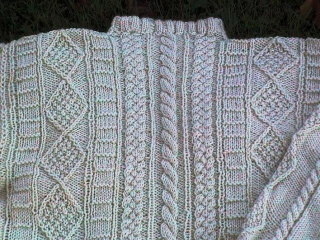
Cable patterns usually consist
of stockinette stitches on a reverse stockinette
background in order to “raise” the
cables off the surface, giving them an embossed
appearance.
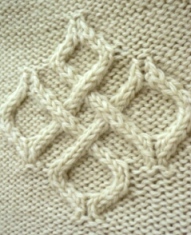
Cables can be made by utilizing
a special tool called a cable stitch holder …
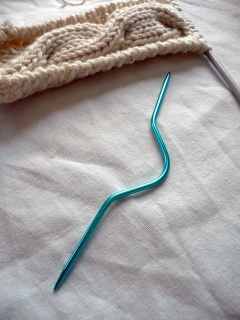
… an extra double point needle or - as I’ll
be showing you a bit further on - with no special
tools at all!
Let me say right away that once
you learn the basic method of creating a cable – getting
those stitches knitted “out of order” – no
cable will be too complicated for you. Not even
these…
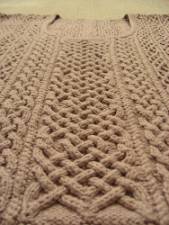
Morrigan [designed by Jenna Wilson, from
the book No Sheep for You]
Knit and photographed by Laura Prescott
The only difference between creating
this masterpiece and working the simple 6 stitch
cable I’m about to show you is that the former
takes a bit more patience. (Well, patience, good
organizational skills and a hefty dose of willpower.)
A few more facts about cables:
1. Cables make a dense fabric
that is significantly less yielding than regular
stockinette. This means that more ease is required
in a heavily cabled garment than in one without
cables.
2. Cables “pull in” laterally
which affects stitch gauge significantly. In other
words a heavily cabled sweater will have you casting
on many more stitches than the same sized sweater
knit in stockinette. (Of course, this also means
that you’re going to need more yarn!) Here
you can see the tendency of cables to pull in at
the point where the cable was made:
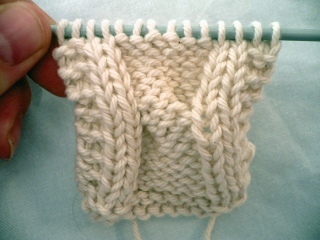
3. Since cabled garments are
quite dense, they require a yarn that is NOT. The
yarn needs to have a certain springiness or “bounce”.
Wool has this bounce naturally, while things like
100% cotton or silk do not. A cabled sweater knit
in 100% cotton -- which tends to be dense and inelastic
-- will be enormously heavy and stretch lengthwise
rather than hold its shape. (If you are interested
in knitting in non-animal fibers, I cannot recommend
our beloved editor’s book No Sheep For
You highly enough.)
And now down to business. We
shall be making a simple 6-stitch cable with both
a front cross and a back cross.
Front cross cable
A “front cross” cable
simply means holding the stitches that are “waiting” to
be knit in front of the work. Front cross cables
are said to twist to the left, which simply means
that the stitches on top in the finished cable
seem to veer off to the left.
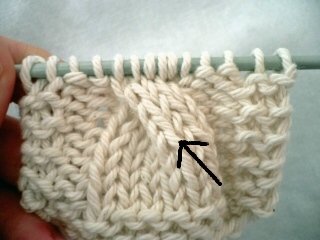
A six-stitch
cable consists of 6 stockinette stitches. Some
stitch dictionaries will say a 6 stitch cable
is made on a panel of 10 stitches – this
includes the two purl stitches that are customarily
on either side of the 6 knit stitches in the
center.
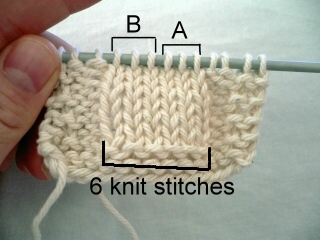
Knit to the beginning
of the center group of knit stitches.
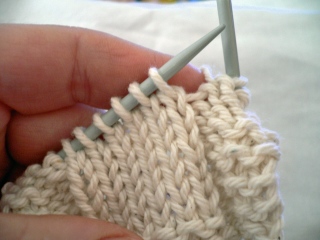
Slip the first 3 stitches (A)
to a spare double-point needle (or cable stitch
holder) and hold these stitches in front of the
work.
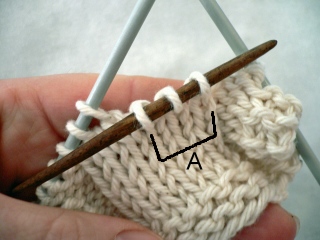
Ignoring the three stitches being
held on the extra needle for the moment, knit the
second 3 stitches (B).
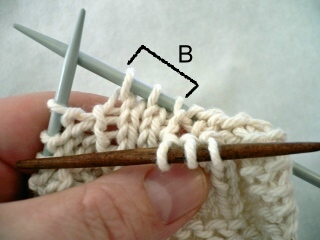
Then knit the three stitches
that were being held on the extra needle.
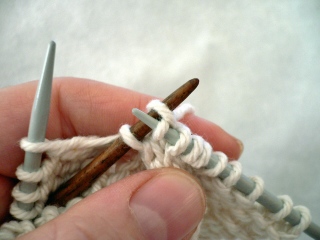
Voila! One front cross cable
completed. Let’s do one back cross cable
before we get sneaky and throw out our cable holding
needle, shall we?
Back cross cable
The entire process is the same,
except you’ll be holding the needle with
the waiting stitches at the BACK of the work, like
so:
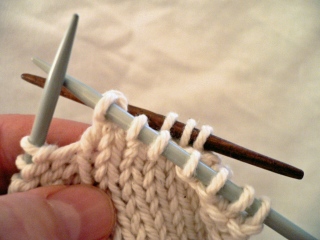
Back cross cables always twist
to the RIGHT.
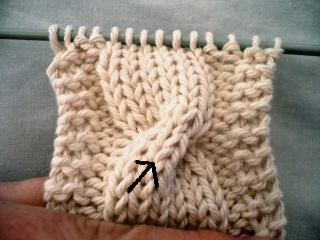
The loose purl stitches
issue
One of the most common problems
with cabling is that the purl stitches immediately
following the crossing can be quite loose due to
the strain of the crossed stitches.
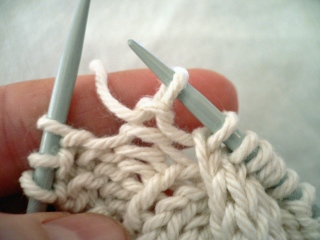
This can, in extreme
cases, make the cabled stitches warped and leave
small open areas to the left of your cables. One
way to correct this is to make it a habit of giving
the yarn an extra tug while working the first couple
of purl stitches…
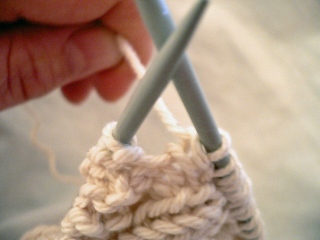
…to make sure the purl
stitches sit nice and snug up against the cable.
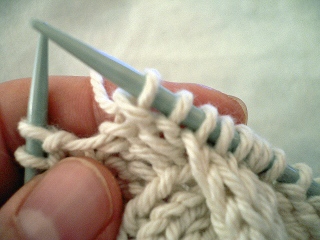
Another option is to twist the
purl stitches by knitting them through the back
loop.
Cabling without a cable
needle
Now that we’ve got cabling
down, let’s go one step further and talk
about cabling without that extra needle for holding
the waiting stitches. It does require a bit of
faith – faith that your knitting won’t
immediately unravel completely when you pull your
needles out. A bit of faith in your ability to pick
up stitches if they did drop is also helpful.
Front cross cable without
a cable needle:
Knit to the stitches to be cabled.
Slip them ALL to the right-hand needle as if to
purl (one at a time or as a group, either way is
fine.)
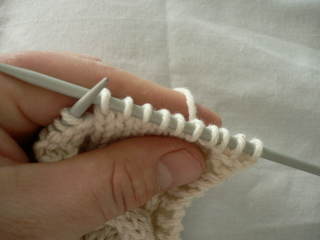
Insert the left-hand needle into
the stitches that would otherwise be held on
the extra needle from the front…
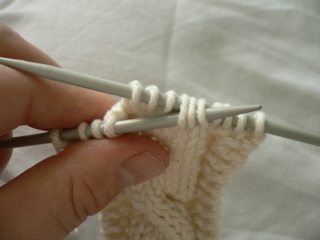
… and then – take
a deep breath - remove the right-hand needle from
all the stitches, which will leave half the stitches
kind of hanging in space. It will be ok. They won’t
go anywhere if you keep your head and work quickly.
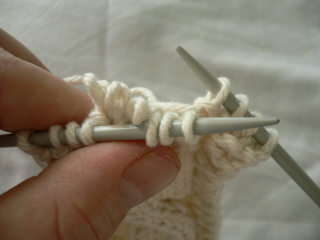
Reinsert the right-hand needle
into the needle-less stitches:
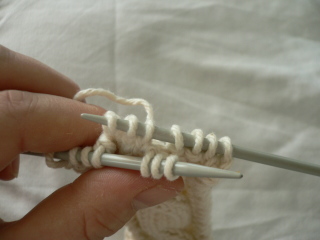
Now pull your needles apart enough
to slip all the stitches that have not been knitted,
one at a time, from the right-hand needle to the
left-hand needle.
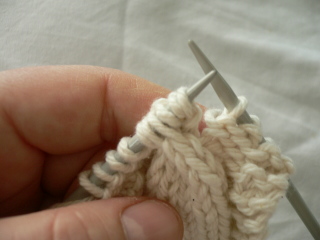
What you have accomplished here
is the cable cross without having knitted it yet.
The only step left is to knit those stitches! They
are all going to seem very tight, but press on
and you’ll wind up with a lovely front cross
cable without having to hunt through your knitting
junk drawer for your cable needle.
Back cross cable without a
cable needle:
Again, knit to the stitches to
be cabled. Slip them to the right hand needle and
then reinsert the left hand needle into the stitches
that would otherwise be held on the extra needle but
this timefrom the back and into the back loop
of the stitches …
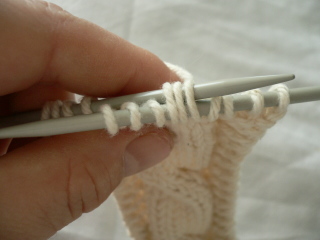
Pull the right-hand needle out
and reinsert it into the needle-less stitches,
which will now be in front.
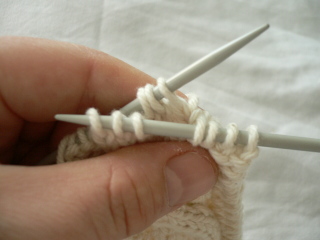
Slip the un-knitted stitches
from the right-hand needle to the left-hand needle
and knit over all.
And now you have a finished right
twist cable!
Resources:
Knitting
in the Old Way by Priscilla Gibson-Roberts
A
Treasury of Knitting Patterns by
Barbara G. Walker
|

